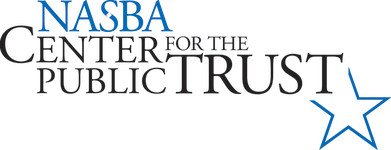CPT Co-Sponsors 6th Annual Baruch Audit Conference
 Ethics Matters, Jan-Feb 2012
Ethics Matters, Jan-Feb 2012
A day before the 10th anniversary of Enron’s spectacular bankruptcy filing, on December 1, 2011, the NASBA Center for the Public Trust with Baruch College, of the City University of New York, held its Sixth Annual Auditing Conference on “Ensuring Integrity.” Moderator Douglas Carmichael, Baruch professor and former Chief Auditor of the Public Company Accounting Oversight Board, noted the conference’s strong regulatory focus was particularly fitting as Enron’s anniversary was remembered. Conference speakers included representatives of the PCAOB, Securities and Exchange Commission, AICPA Auditing Standards Board, and major accounting and law firms. In the audience were public accounting practitioners, academics, students and representatives of the press, many of whom have made the Baruch/CPT Annual Auditing Conference a regular event on their calendars.
“The financial reporting and auditing environments are still challenging,” Martin F. Baumann, PCAOB Chief Auditor and Director of Professional Standards, told conference attendees. “Audit risk continues to be high as the economy is soft,” he continued. With Auditing Standards Nos. 8-15, relating to the auditor’s assessment and response to risk, going into effect with this year’s audits, the PCAOB believes the audit process will be improved.
In June 2011, the PCAOB issued a concept release on the auditor’s reporting model, resulting in 152 comment letters. Mr. Baumann said a proposal to change the auditor’s report is expected to be issued in the second quarter of 2012, but no decisions on how that will be done have been made yet. Most of the concept release comments favored keeping the pass/fail opinion, but investor associations, pension managers and analysts want the auditors to disclose more, including audit procedures. They prefer more information from the auditors regarding the financial statements and the audit, rather than assurance on information outside the financial statements or clarification, he reported.
To help address the criticism that auditors are not adequately challenging management’s assertions, the PCAOB issued a concept release proposing to limit the number of consecutive years for which a registered public accounting firm could serve as the auditor of a public company. Mr. Baumann noted the concept release also seeks comments on other measures that could meaningfully enhance auditor independence, objectivity and professional skepticism. He said the PCAOB will be holding roundtable discussions on its findings in March 2012.
Dr. Carmichael asked panelist Matthew M. Waldron, Director of Financial Reporting Policy at CFA Institute, how the cost/benefit value would be equated if auditors are to provide more information to investors. Mr. Waldron said the investors just want a report that tells them what the auditors did. It is the investors who pay the audit fees, he stated, and added that it was not unreasonable to think there will be an auditor fee increase for the increased information. Dr. Carmichael then asked Mr. Waldron what his “wish list” for information from the auditor would be. He replied, “More about risk assessment. We’re not asking for assurance – just tell us what you have done thus far.”
The impact of the PCAOB’s proposed amendments to improve transparency through disclosure of the engagement partner and certain other participants in audit reports was debated by attorneys representing the accounting profession and by regulators. Claudius B. Modesti, PCAOB Director of Enforcement and Investigations, and Alison T. Conn, Assistant Director of the SEC’s Enforcement, told the attendees that their divisions coordinate efforts and can obtain the names of the engagement partners and firms that are involved in the financial reports. The proposal raises the issue of transparency to the public. Howard A. Smith, head of litigation at Deloitte, LLP, said that naming the individual partner in the financial report heightens the risk of liability exposure. Michael Young, Litigation Partner for Willkie Farr & Gallagher, was not certain it would, but observed, “An adversary system of justice does not go with transparency.”
Mr. Modesti stated, “We have to be fair and just – that is what we have to be about.” NASBA President and CEO David A. Costello told the audience, “Behind the numbers is the trust.”
Other conference speakers included: Darrel Schubert, Chair of the AICPA’s Auditing Standards Board; Brian Croteau, Deputy Chief Accountant for the Professional Practice Group of the Securities and Exchange Commission; Helen Munter, Director of the PCAOB’s Division of Registration and Inspections; and Dan Guy, litigation consultant and former AICPA Vice President – Professional Standards.




